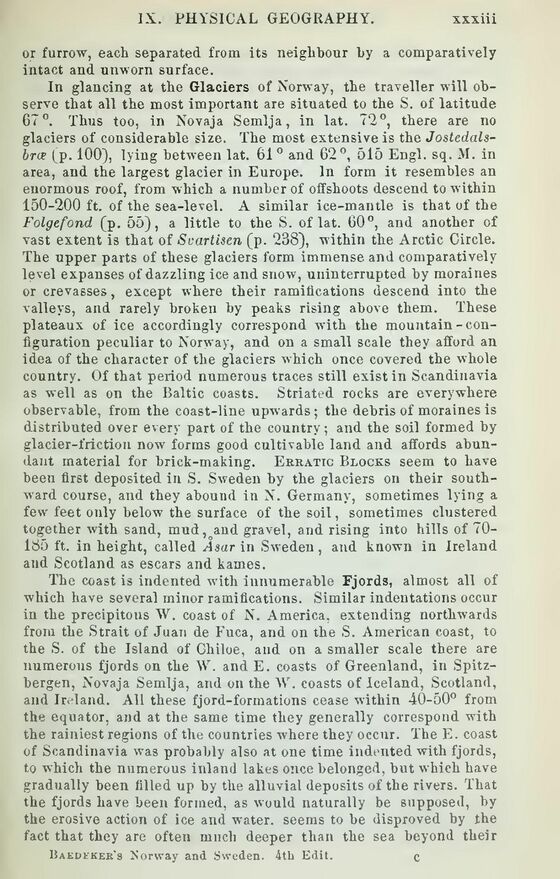
Full resolution (JPEG) - On this page / på denna sida - Introduction - Pages ...

<< prev. page << föreg. sida << >> nästa sida >> next page >>
Below is the raw OCR text
from the above scanned image.
Do you see an error? Proofread the page now!
Här nedan syns maskintolkade texten från faksimilbilden ovan.
Ser du något fel? Korrekturläs sidan nu!
This page has never been proofread. / Denna sida har aldrig korrekturlästs.
or furrow, each separated from its neighbour by a comparatively
intact and. unworn surface.
In glancing at the Glaciers of Norway, the traveller will
observe that all the most important are situated to the S. of latitude
67°. Thus too, in Novaja Semlja, in lat. 72°, there are no
glaciers of considerable size. The most extensive is the
Jostedals-bræ (p. 100), lying between lat. 61 0 and 62°, Ö1Ö Engl. sq. Ml in
area, and the largest glacier in Europe. In form it resembles an
enormous roof, from which a number of offshoots descend to within
150-200 ft. of the sea-level. A similar ice-mantle is that of the
Folgefond (p. 55), a little to the S. of lat. 60°, and another of
vast extent is that of Svartisen (p. 238), within the Arctic Circle.
The upper parts of these glaciers form immense and comparatively
level expanses of dazzling ice and snow, uninterrupted by moraines
or crevasses, except where their ramifications descend into the
valleys, and rarely broken by peaks rising above them. These
plateaux of ice accordingly correspond with the
mountain-configuration peculiar to Norway, and on a small scale they afford an
idea of the character of the glaciers which once covered the whole
country. Of that period numerous traces still exist in Scandinavia
as well as on the Baltic coasts. Striated rocks are everywhere
observable, from the coast-line upwards; the debris of moraines is
distributed over every part of the country; and the soil formed by
glacier-friction now forms good cultivable land and affords
abundant material for brick-making. Ekkatic Blocks seem to have
been first deposited in S. Sweden by the glaciers on their
southward course, and they abound in N. Germany, sometimes lying a
few feet only below the surface of the soil, sometimes clustered
together with sand, mud,oand gravel, and rising into hills of
70185 ft. in height, called Asar in Sweden, and known in Ireland
and Scotland as escars and kames.
The coast is indented with innumerable Fjords, almost all of
which have several minor ramifications. Similar indentations occur
in the precipitous W. coast of N. America, extending northwards
from the Strait of Juan de Fuca, and on the S. American coast, to
the S. of the Island of Ghiloe, and on a smaller scale there are
numerous fjords on the \Y. and E. coasts of Greenland, in
Spitz-bergen, Novaja Semlja, and on the W. coasts of Iceland, Scotland,
and Ireland. All these fjord-formations cease within 40-50° from
the equator, and at the same time they generally correspond with
the rainiest regions of the countries where they occur. The E. coast
of Scandinavia was probably also at one time indented with fjords,
to which the numerous inland lakes once belonged, but which have
gradually been filled up by the alluvial deposits of the rivers. That
the fjords have been formed, as would naturally be supposed, by
the erosive action of ice and water, seems to be disproved by the
fact that they are often much deeper than the sea beyond their
Baedeker’s Norway and Sweden. 4th Edit. C
<< prev. page << föreg. sida << >> nästa sida >> next page >>